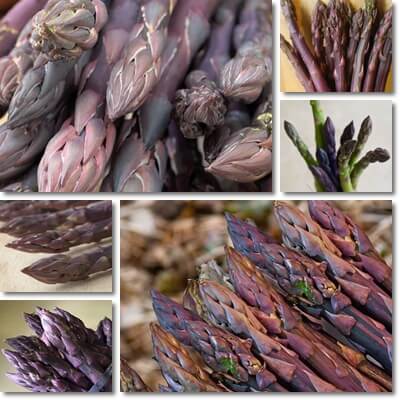Purple asparagus is a spring vegetable in season from roughly mid-April to late June. Despite its unusual color, it is actually a variety of green asparagus, scientifically known as Asparagus officinalis. The young stems or spears are tender and have a pleasant taste with mild sweet, earthy and even nutty flavor notes. The purple-violet color of purple asparagus is indicative of the presence of anthocyanin antioxidants with free radical-scavenging, antimicrobial and immune system boosting properties. With a nutrition value similar to its green counterpart, it holds benefits for weight loss, digestion, blood sugar control and benefits for cardiovascular and nervous system health.
Purple vs green asparagus
Purple asparagus is a variety of green asparagus. Botanically speaking, they are the same plant, Asparagus officinalis. The difference in color commands different antioxidant profiles, with purple asparagus containing anthocyanin antioxidants vs green asparagus which contains chlorophyll. There are some minor differences in nutritional value as well, notably differences in sugar, fiber and vitamin K content. Flavor profile is also different, the purple variety having a sweeter taste. Overall, it can be considered that purple and green asparagus have roughly the same appearance, except for the skin color), and similar, but not identical nutritional value and health benefits. The best purple asparagus varieties are: Pacific Purple, Purple Passion, Stewarts Purple and Sweet Purple.

What does purple asparagus look like?
Purple asparagus is a stem vegetable, that is, the main edible part is the above-ground stem or stalk. The stems can grow to up to 1.5 meters tall, but are typically harvested at around 15-30 cm, when still young and tender. As for appearance, the stems are slender-looking, that is long and thin, but sturdy, and purple-violet in color. Starting at the base there are purple-violet scale-like leaves that cluster at the top in what looks like a spear-shaped tip. An interesting fact about purple asparagus is that it’s purple only on the outside. When you peel it, the flesh is revealed to be pale green near the skin and creamy white towards the middle of the stem. Varieties of asparagus with both green and purple-violet also exist (either the tops are purple-violet and the rest of the stem green, or most of the tops and most of the stalks are purple-violet, with some green).
What does purple asparagus taste like?
If harvested timely, purple asparagus should be tender, with a mild, but overall quite pleasant taste. Because the sugar content in purple asparagus is higher than in green asparagus, there is a noticeable sweetness to the purple variety. Soil and weather conditions and the age of the plant at harvest affect flavor profile. Overall, mild earthy, faint nutty, almond-like flavor notes and a taste reminiscent of artichokes, with muted bitter notes may be observed in purple asparagus. If harvested late, purple asparagus stems can become fibrous, tough and woody, which definitely takes away from the taste experience. Important: asparagus fruits, which are small, red berries, are toxic and must not be eaten.
Harvesting and cooking tips
First of all, harvest your stems young, ideally when they’re 15-20 cm tall, but no more. Cut your purple asparagus with a knife or break off the stems by hand to harvest them. Now you have several options: either eat the same day or place the stems in a glass of water and keep for several days (similar to parsley), or refrigerate for up to a week. The tender stems don’t even need cooking: they can be eaten fresh or raw, in salads or considered as raw side-dishes for meat and vegetable-based meals. If you do cook them, remember that anthocyanins, the color-giving compounds in purple asparagus, are water soluble and will leak out of the stems if boiled or otherwise cooked in liquid. Light cooking and adding an acidic ingredient such as lemon or lime juice or vinegar helps maintain and enhance color.

To prepare for cooking:
1) If the stems are thin and tender, they can be cooked as they are.
2) If the stems are thicker and maybe also older, you may want to cut the tougher, lower ends and discard them. You may also want to peel the purple skin up until the spear-like tip – while this will leave you with mostly green asparagus (because purple asparagus is green underneath), the peeled stems will be tenderer and also cook faster (between 5-10 minutes, depending on how thick the stems are).
Any recipes that require green asparagus work great with purple asparagus too. Preferred ingredients to pair it with include: butter, lime and lemon juice, acidic oranges, grapefruit, ham, bacon, Italian prosciutto, extravirgin olive oil, white or red vinegar, salt, pepper, fresh parsley, onions, garlic, leek, artichokes, lettuce, eggs (soft boiled, omelette), mushrooms (from the readily available button mushrooms or cremini to morels), chopped and roasted hazelnuts, almonds, pecans or walnuts, grated Parmesan cheese, Gorgonzola crumbles and more.
Nutrition facts of purple asparagus
Official authorities have not yet released a complete and comprehensive nutritional profile for purple asparagus. However, the following nutritional facts are known at this point:
- Purple asparagus has a higher sugar content (vs the green variety). It is estimated it contains up to 20% more sugar.
- It is a source of anthocyanins, red, purple, blue and black pigments with antioxidant and immune-system modulating properties (vs the green variety which contains chlorophyll).
- Slightly lower in fiber, but a good source nonetheless, especially if eaten with skin (possible with younger stems).
- Source of vitamin K, although lower in the vitamin compared to the green variety.
- Good source of protein, low in calories and especially low in fat.
- Contains asparagine, a non-essential amino acid with important benefits for brain and nervous system health and protein-forming properties.
- Contains a variety of essential micro-nutrients, notably good amounts of vitamins B1, B2, B3, B5, B6 and B9, vitamins A, C, E, K and choline, particularly amounts of iron and small amounts of magnesium, manganese, phosphorus, potassium and zinc.
- Almost sodium-free, based on sodium intake guidelines.
- Rich in antioxidants: purple-violet anthocyanins, green chlorophyll, carotenes and other flavonoids, micro-nutrients (vitamins and dietary minerals, especially copper, iron, manganese).
Purple asparagus health benefits
- Purple asparagus is extremely low in fat and low in calories (around 20 kcal per 100 g) and a source of protein and dietary fiber – can be considered for a weight loss diet plan.
- Hold minor benefits for digestion and constipation relief thanks to dietary fiber content.
- Extremely low in sodium, it is a good food to include in low-sodium diets for anyone with hypertension (high blood pressure).
- Helps reduce swelling because it is high in water and at the same time low in sodium and contains micro-nutrients and other biologically active compounds with anti-inflammatory properties.
- Free radical scavenging properties thanks to a varied antioxidant profile (anthocyanins, chlorophyll etc.) – helps reduce oxidative stress damage to cells.
- Supports blood coagulation and holds anti-inflammatory benefits thanks to good amounts of vitamin K.
- Promotes strong and healthy bones and teeth thanks to a good vitamin K content which regulates calcium metabolism, phosphorus as well as a generous copper content.
- Benefits for the brain and nervous system thanks to the amino acid asparagine (studies show asparagine helps with brain and nervous system development).
- Improved energy levels and energy metabolism, reduced fatigue thanks to iron and B vitamin content.
- Benefits for skin and nervous system health from B vitamins.
- Benefits for pregnant women thanks to vitamin B9 which promotes the healthy development of the brain and nervous system of babies during pregnancy.
- Boosts the immune system function and holds antioxidant benefits thanks to copper and manganese (the superoxide dismutase antioxidant enzymes SOD1 and SOD3 contain copper, and zinc, while SOD2 contains manganese, all three nutrients present in purple asparagus).
- Potential benefits for regulating blood sugar levels thanks to generous copper content.
- Counteracts fatigue and supports energy metabolism also as a result of copper content.
- Holds benefits for thyroid health thanks to copper and selenium.
Purple asparagus and bad urine smell
There are really no side effects to eating purple asparagus in reasonable amounts. Unless you have a specific pre-existing condition such as a food allergy or blood clotting problem, you should be able to enjoy the spring vegetable without any issues. Excesses can be a source of side effects especially for those with blood clotting problems, receiving anticoagulant medication. Other than this, it doesn’t even color urine like green asparagus does (see more foods that change urine color).
One aspect though can be construed as a side effect: because of the way it’s metabolized, purple asparagus can make urine smell bad. Some find the odor funny, some find it strange or unusual, some find it downright smelly, foul, ammonia-like and may attribute it to a disease or illness (find out more about urine odors and what they mean). Not everyone experiences this though.
The reason why eating purple asparagus may make your urine smell bad is because of the way naturally-occurring sulfur compounds in the vegetable are metabolized and subsequently eliminated through urine. Factors such as low stomach acidity may have a say in how such compounds are metabolized and determine the form in which they are eliminated (smelly or non/less-smelly). Expression of genes also determines a person’s ability to pick up the smell, so it might just be a matter of: ‘the odor is there, but can you smell it?’. In any case, the vegetable is a healthy option to consider for a balanced and varied diet.
